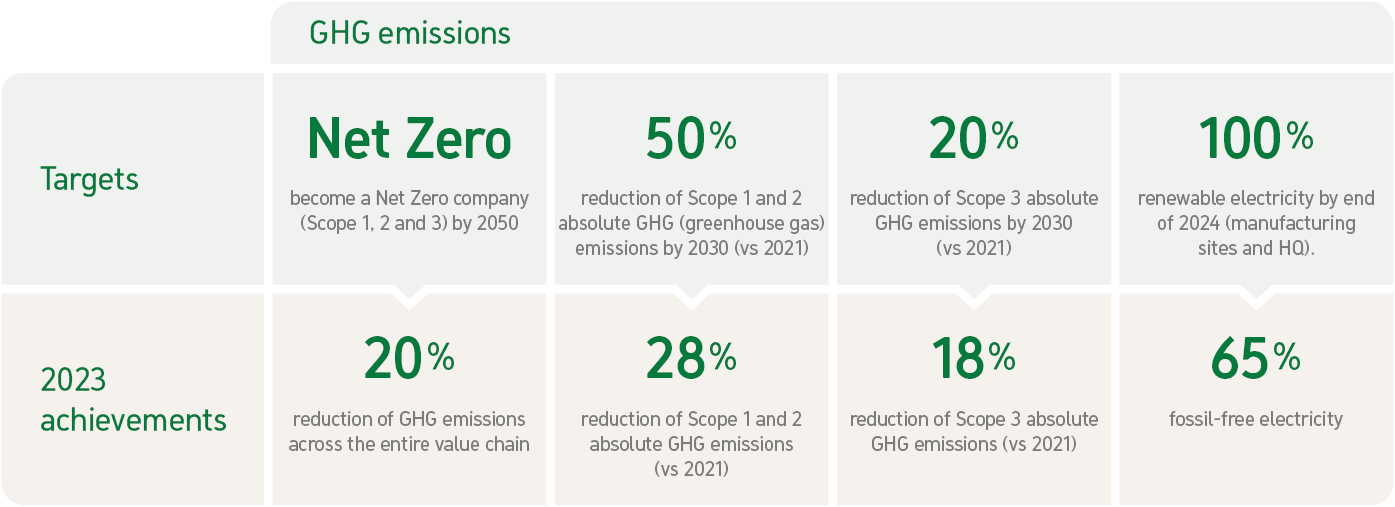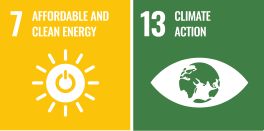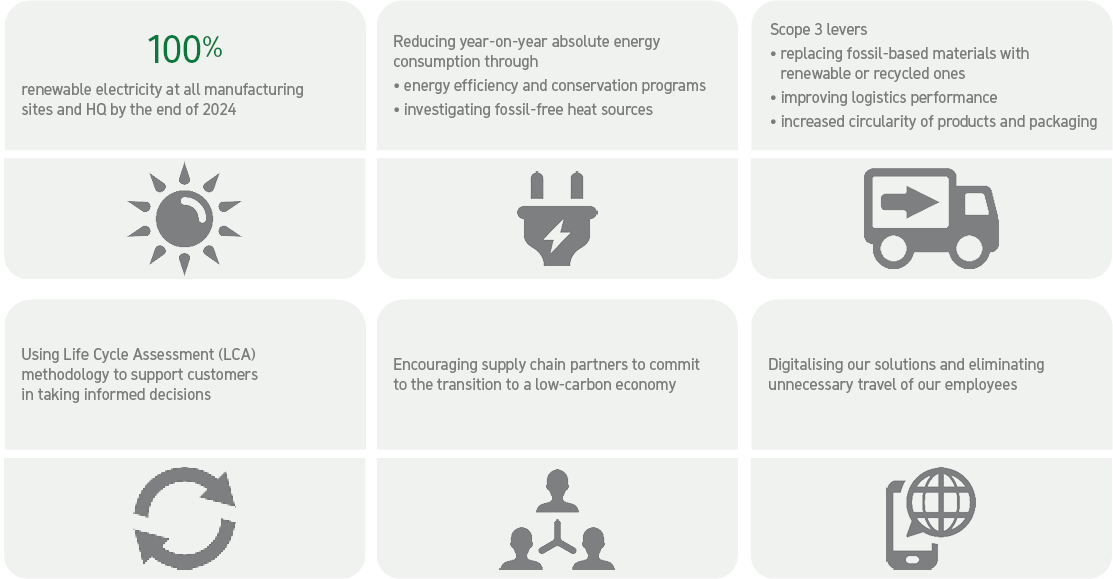GHG emissions and renewable electricity

Committed to reach Net Zero by 2050 at the latest, we have developed a robust roadmap to help healthcare systems decarbonise and to decouple our business from resource constraints. We do it by creating a culture of care for the value of materials, eliminating waste and innovating together with our business partners in order to accelerate transition to a low-carbon economy.
GHG emissions and renewable electricity

Our ambition is to transform our business and become a global leader in sustainable healthcare, decoupling our growth from resource constraints and ending our dependency on virgin fossil materials and fuels.
In 2021, we committed to becoming a Net Zero company by 2050 at the latest and in 2024 Science Based Targets initiative validated our near-term GHG emission reduction targets, confirming that we are fully aligned with the 1.5°C pathway and the ambitions of the Paris Agreement.
The commitment includes our own operations (Scope 1 and 2), as well as Scope 3 upstream and downstream. Scope 3 covers around ~70% of our total emissions (in 2023); it includes for instance purchased goods and services, transportation, application and use of our products, and end-of-life.
Apart from aligning with the 1.5°C pathway, we ramp up developing and delivering sustainable solutions to support the transition to a clean low-carbon economy using the UN Sustainable Development Goals on Affordable and Clean Energy (#7) and Climate Action (#13) as a lens to address challenges, build a strong growth strategy and access new markets along the way.

To make rapid progress in reducing greenhouse gas emissions and reach the Scope 1 and 2 target while maintaining long-term business growth, a clear plan has been established to transition to 100% fossil-free electricity by the end of 2024 and continually reduce our absolute energy consumption year-on-year, while looking into fossil-free heat sources. We actively pursue energy efficiency and conservation programmes at our locations across the globe.
The target on fossil-free electricity is progressing well, with a current (2023) total share of renewable electricity use of 65% globally and 9 facilities operating entirely on renewable electricity, using solar panels, renewable electricity supply from the grid and Energy Attribute Certificates (EACs) supply from the grid (please see Mölnlycke Annual Report 2023 for details). We have made a significant progress in our efforts to increase the share of renewable electricity from sources with higher additionality in the near future, with sites in Malaysia and UK having completed the installation of solar photovoltaic systems forecasted to account for 10% and 12.4% of the sites’ annual electricity consumption respectively. The work on the solar panel installation on our factories in Thailand is underway. We signed a virtual Power Purchase Agreements (vPPA) for a wind farm in Finland also covering the factories in Belgium, Czech Republic and Denmark (35 GWh/y during 10 years). Another vPPA with a renewable energy generator in Malaysia is expected to be signed in 2024.
We partner with customers and suppliers to drive sustainable innovation to reduce GHG emissions in our value chains across our businesses. Below are just a few examples of the work we do to reduce GHG emissions in our value chains:
Moreover, we have introduced GHG emissions assessment into relevant investment requests to drive further awareness of the environmental and future economic impact of major decisions, and to strengthen the sustainability of our business portfolio as a result.
Moreover, we have introduced GHG emissions assessment into relevant investment requests to drive further awareness of the environmental and future economic impact of major decisions, and to strengthen the sustainability of our business portfolio as a result. An internal carbon price for investment decisions has been included, anticipating the impact of any future carbon pricing. The internal price of carbon implemented is uniform and static and set to a relatively high level, 100€/t, to internalise potential future costs of carbon in the long term. It enables the management to arbitrate between different options, to choose the most virtuous and efficient ones to achieve the goals of Net Zero by latest 2050. Mölnlycke’s suppliers and customers might be impacted by carbon pricing, which creates both risks and opportunities. For example, the company can mitigate the carbon cost impact for their customers by offering sustainable solutions.
Our GHG value chain emissions (Scope 1, 2 and 3) are made transparent through our external sustainability reporting, which is in line with the GHG Protocol. We also report climate risks and low carbon opportunities through the CDP Climate questionnaire for the benefit of all our stakeholders. We use key indicators to track our progress and drive continuous improvement processes in every function, supported by external benchmarks.
We support the recommendations from Task Force on Climate-related Financial Disclosures (TCFD) and include those disclosures in our external sustainability reporting. We recognise that climate change will pose risks as well as opportunities for us and our customers, both directly through our operations and indirectly through our stakeholder activities. Therefore, we will listen to the needs of our stakeholders when operating and providing our solutions.
Finally, we have introduced GHG emission reductions in our travel policy for all employees, by reducing unnecessary travel or switching to alternative ways of travelling using more efficient and fossil-free transportation means.

